3
Chapter Learning Outcomes
- Define culture and understand it as an evolutionary adaptation that humans rely on to exist in social structures.
- Explain how the dominant ideology influences the creation of culture.
- Describe the components of culture and understand the relationship between material and non-material culture.
- Discuss the different types of cultural groups, including subculture, counterculture and dominant culture.
- Understand and be able to apply the following concepts: ethnocentrism, cultural relativism, cultural lag, culture shock and cultural leveling.
- Outline the means through which cultures change.
Social Issues in the News
“Cows with Gas,” the headline said. In India, cows are considered sacred by that nation’s major religion, Hinduism. They are also an important source of milk and fertilizer. It is no surprise that India has almost 300 million cows, the highest number in the world, and that they roam freely in Indian cities and towns. But one problem of this abundance of cows is the methane gas they excrete as they belch. They emit so much methane that scientists think Indian cows, along with some 180 million sheep and goats, are a significant cause of global warming. One reason Indian livestock emit so much methane, aside from their sheer numbers, is that they are underfed and undernourished; better diets would reduce their methane emission. However, India cannot cost-effectively feed these cattle. The prospect of a better diet for livestock remains years away, and the problem of cows with gas will continue for some time to come (Singh, 2009).
The idea of cows with too much gas, or any gas at all, roaming city streets is probably not very appealing, but cow worship is certainly a part of India’s culture. This news story provides just one of many examples of the importance of cultural differences for beliefs and behaviors.

Here is a more pleasing example. When you are in love, what can be more natural and enjoyable than kissing? This simple act is the highlight of countless movies and television shows in industrialized cultures where two people meet each other, often not liking each other at first, but then slowly but surely fall madly in love and have their first magical kiss. What we see on the screen reflects our own interest in kissing. When we reach puberty, many of us yearn for our first kiss. That kiss is as much a part of growing up as almost anything else we can think of, and many of us can remember when, where, and with whom our first kiss occurred.
Kissing certainly seems a natural, enjoyable act to most of us, but evidence from some societies indicates kissing might not be so natural after all. In some preindustrial societies such as the Balinese and Tinguian of Oceania, the Chewa and Thonga of Africa, and the Siriono of South America, kissing is unknown, as the people there think it is unhealthy and disgusting. When the Thonga first saw Europeans kissing, they retorted, “Look at them—they eat each other’s saliva and dirt” (Ford & Beach, 1972, p. 49). Even in industrial societies, kissing is not always considered desirable. Until fairly recently, the Japanese abhorred kissing and did not even have a word for it until they created kissu from the English kiss, and even today older Japanese frown on kissing in public. Reflecting the traditional Japanese view, when Rodin’s famous statue The Kiss arrived in Japan in the 1920s as part of a European art show, the Japanese hid it behind a curtain. In other societies, people do kiss, but their type of kissing differs greatly from what we are used to. In one of these, people kiss the mouth and the nose simultaneously, while people in a few other societies kiss only by sucking the lips of their partners (Tanikawa, 1995; Tiefer, 1995).
3.1 Culture and the Sociological Perspective
As this evidence on kissing suggests, what seems to us a very natural, even instinctual act turns out not to be so natural and biological after all. Instead, kissing seems best understood as something we learn to enjoy from our culture, or the symbols, language, norms, beliefs, values, and artifacts (material objects) that are part of a society. Because society refers to a group of people who live in a defined territory and who share a culture, it is obvious that culture is a critical component of any society.
If the culture we learn influences our beliefs and behaviors, then culture is a key concept to the sociological perspective. Someone who grows up in the United States differs in many ways, some of them obvious and some of them not so obvious, from someone growing up in China, Sweden, South Korea, Peru, or Nigeria. Culture influences not only language but the gestures we use when we interact, how far apart we stand from each other when we talk, and the values we consider most important for our children to learn, to name just a few. Without culture, we could not have a society. In addition, culture, and therefore society, is changing constantly. You will learn of many examples of cultural and social change throughout this book.
The profound impact of culture becomes most evident when we examine behaviors or conditions that, like kissing, are normally considered biological in nature. It is important to note here that the human species is homogenous which means that all of us have very similar genetic material. It is likely that many of the different reactions we have to external stimuli are culturally induced. Otherwise, we would all react similarly despite having different cultures. Consider morning sickness and labor pains, both very familiar to pregnant women in the United States before and during childbirth, respectively. These two types of discomfort have known biological causes based on Western medical research, and we are not surprised that so many pregnant women experience them. But we would be surprised if the husbands of pregnant women woke up sick in the morning or experienced severe abdominal pain while their wives gave birth. These men are neither carrying nor delivering a baby, and there is no logical—that is, biological—reason for them to suffer either type of discomfort.
And yet some scholars have studied several preindustrial societies in which men about to become fathers experience precisely these symptoms. They are nauseous during their wives’ pregnancies, and they experience labor pains while their wives give birth. The term couvade refers to these symptoms, which do not have any known biological origin. Yet the men feel them nonetheless, because they have learned from their culture that they should feel these types of discomfort (Doja, 2005). And because they should feel these symptoms, they actually do so. As sociologists William I. and Dorothy Swaine Thomas (1928) once pointed out, if things are perceived as real, then they are real in their consequences.
It is even more surprising to a person socialized in an industrialized culture to consider that the biological norms we experience are themselves shaped by cultural expectations, despite learning about them as natural physical experiences. The example of drunkenness illustrates this. In the United States, when people drink too much alcohol, they become intoxicated and their behavior changes. Most typically, their inhibitions lower and they become loud, boisterous, and even rowdy. We attribute these changes to alcohol’s biological effect as a drug on our central nervous system, and scientists have documented how alcohol breaks down in our body to achieve this effect.

Culture affects how people respond when they drink alcohol. Americans often become louder and lose their sexual inhibitions when they drink, but people in some societies studied by anthropologists often respond very differently, with many never getting loud or not even enjoying themselves.
This explanation of alcohol’s effect is OK as far as it goes, but it turns out that how alcohol affects our behavior depends on our culture. In some small, preindustrial societies, people drink alcohol until they pass out, but they never get loud or boisterous; they might not even appear to be enjoying themselves. In other societies, they drink lots of alcohol and get loud but not rowdy. In some societies, including our own, people lose sexual inhibitions as they drink, but in other societies they do not become more aroused. The cross-cultural evidence is very clear: alcohol as a drug does affect human behavior, but culture influences the types of effects that occur. We learn from our culture how to behave when drunk just as we learn how to behave when sober (McCaghy, Capron, Jamieson, & Carey, 2008).
Culture and Biology
These examples suggest that human behavior is heavily influenced by culture. This is not to say that biology does not have an impact on your behaviors. As just one example, humans have a biological need to eat, and so they do. But humans are much less under the control of biology than any other animal species, including other primates. These and other animals are governed more so by biological instinct. A dog chases any squirrel it sees because of instinct, and a cat chases a mouse for the same reason. Different breeds of dogs do have different personalities, but even these stem from the biological differences among breeds passed down from one generation to another. Instinct prompts many dogs to turn around before they lie down, and it prompts most dogs to defend their territory. When the doorbell rings and a dog begins barking, it is responding to an evolved biological instinct.
Because humans have such a large, complex central nervous system, we are less controlled by biology. The critical question then becomes, how much does biology influence our behavior? Predictably, scholars in different disciplines answer this question in different ways. Most sociologists and anthropologists would probably say that culture affects behavior more than biology does. In contrast, many biologists and psychologists would give much more weight to biology. Advocating a view called sociobiology, some scholars say that several important human behaviors and emotions, such as competition, aggression, and altruism, stem from our biological makeup. Sociobiology has been roundly criticized and just as staunchly defended, and respected scholars continue to debate its premises (Freese, 2008).
Why do sociologists generally favor culture over biology? Two reasons stand out. First, and as we have seen, many behaviors differ dramatically among societies in ways that show the strong impact of culture. Second, biology cannot easily account for why groups and locations differ in their rates of committing certain behaviors. For example, what biological reason could explain why suicide rates west of the Mississippi River are higher than those east of it or why the U.S. homicide rate is so much higher than Canada’s? Various aspects of culture and social structure seem much better able than biology to explain these differences.
Many sociologists also warn of certain implications of biological explanations. First, they say, these explanations implicitly support the status quo. Because it is difficult to change biology, any problem with biological causes cannot be easily fixed. A second warning harkens back to a century ago, when perceived biological differences were used to justify forced sterilization and mass violence, including genocide, against certain groups. As just one example, in the early 1900s, some 70,000 people, most of them poor and many of them immigrants or Black, were involuntarily sterilized in the United States as part of the eugenics movement, which said that certain kinds of people were biologically inferior and must not be allowed to reproduce (Lombardo, 2008). The Nazi Holocaust a few decades later used a similar eugenics argument to justify its genocide against Jews, Catholics, gypsies, and gays (Kuhl, 1994). With this history in mind, some scholars fear that biological explanations of human behavior might still be used to support views of biological inferiority (York & Clark, 2007).
3.2 The Elements of Culture
Culture was defined earlier as the symbols, language, beliefs, values, and artifacts that are part of any society. As this definition suggests, there are two basic components of culture: ideas and symbols on the one hand and artifacts (material objects) on the other. The first type, called nonmaterial culture, includes the values, beliefs, symbols, and language that define a society. The second type, called material culture, includes all the society’s physical objects, such as its tools and technology, clothing, eating utensils, and means of transportation. These elements of culture are discussed next.
Symbols
Every culture is filled with symbols, or things that stand for something else and that often evoke various reactions and emotions. Some symbols are actually types of nonverbal communication, while other symbols are in fact material objects. As the symbolic interactionist perspective emphasizes, shared symbols make social interaction possible.
Let’s look at nonverbal symbols first. A common one is shaking hands, which is done in some societies but not in others. It commonly conveys friendship and is used as a sign of both greeting and departure. Probably all societies have nonverbal symbols we call gestures, movements of the hands, arms, or other parts of the body that are meant to convey certain ideas or emotions. However, the same gesture can mean one thing in one society and something quite different in another society (Axtell, 1998). In the United States, for example, if we nod our head up and down, we mean yes, and if we shake it back and forth, we mean no. In Bulgaria, however, nodding means no, while shaking our head back and forth means yes! “Thumbs up” in the United States means “great” or “wonderful,” but in Australia it means the same thing as extending the middle finger in the United States. Certain parts of the Middle East and Asia would be offended if they saw you using your left hand to eat, because they use their left hand for bathroom hygiene.
Some of our most important symbols are objects. Here the U.S. flag is a prime example. For most Americans, the flag is not just a piece of cloth with red and white stripes and white stars against a field of blue. Instead, it is a symbol of freedom, democracy, and other American values and, accordingly, inspires pride and patriotism. During the Vietnam War, however, the flag became to many Americans a symbol of war and imperialism. Some burned the flag in protest, prompting angry attacks by bystanders and negative coverage by the news media.
Other objects have symbolic value for religious reasons. Three of the most familiar religious symbols in many nations are the cross, the Star of David, and the crescent moon, which are widely understood to represent Christianity, Judaism, and Islam, respectively. Whereas many cultures attach no religious significance to these shapes, for many people across the world they evoke very strong feelings of religious faith. Recognizing this, hate groups have often desecrated these symbols.
As these examples indicate, shared symbols, both nonverbal communication and tangible objects, are an important part of any culture but also can lead to misunderstandings and even hostility. These problems underscore the significance of symbols for social interaction and meaning.
Language
Perhaps our most important set of symbols is language. In English, the word chair means something we sit on. In Spanish, the word silla means the same thing. As long as we agree how to interpret these words, a shared language and thus society are possible. By the same token, differences in languages can make it quite difficult to communicate. For example, imagine you are in a foreign country where you do not know the language and the country’s citizens do not know yours. Worse yet, you forgot to bring your dictionary that translates their language into yours, and vice versa, and your iPhone battery has died. You become lost. How will you get help? What will you do? Is there any way to communicate your plight?

As this scenario suggests, language is crucial to communication and thus to any society’s culture. Children learn language from their culture just as they learn about shaking hands, about gestures, and about the significance of the flag and other symbols. Humans have a capacity for language that no other animal species possesses. Our capacity for language in turn helps make our complex culture possible.
In the United States, some people consider a common language so important that they advocate making English the official language of certain cities or states or even the whole country and banning bilingual education in the public schools (Ray, 2007). Critics acknowledge the importance of English but allege that this movement incites anti-immigrant prejudice and would help destroy ethnic subcultures. In 2009, voters in Nashville, Tennessee, rejected a proposal that would have made English the city’s official language and required all city workers to speak in English rather than their native language (R. Brown, 2009).
Language, of course, can be spoken or written. One of the most important developments in the evolution of society was the creation of written language. Some of the preindustrial societies that anthropologists have studied have written language, while others do not, and in the remaining societies the “written” language consists mainly of pictures, not words. Figure 3.1 “The Presence of Written Language (Percentage of Societies)” illustrates this variation with data from 186 preindustrial societies called the Standard Cross-Cultural Sample (SCCS), a famous data set compiled several decades ago by anthropologist George Murdock and colleagues from information that had been gathered on hundreds of preindustrial societies around the world (Murdock & White, 1969). In Figure 3.1 “The Presence of Written Language (Percentage of Societies)”, we see that only about one-fourth of the SCCS societies have a written language, while about equal proportions have no language at all or only pictures.
Figure 3.1 The Presence of Written Language (Percentage of Societies)

The acceptable use of one or more languages compared to others is a good example of how the dominant ideology works. The dominant ideology is the legitimate norms and values within a society; any norms and values besides these are typically illegitimate or not accepted. The norms and values of the more powerful social groups are the norms and values that are legitimized. The dominant ideology changes over time of course but one always exists. In the above example, you can imagine that a dramatic fluctuation of the Spanish-speaking population would influence the dominant ideology of that society.
To what extent does language influence how we think and how we perceive the social and physical worlds? The famous but controversial Sapir-Whorf hypothesis, named after two linguistic anthropologists, Edward Sapir and Benjamin Lee Whorf, argues that people cannot easily understand concepts and objects unless their language contains words for these items (Whorf, 1956). Language thus influences how we understand the world around us. For example, people in a country such as the United States that has many terms for different types of kisses (e.g. buss, peck, smack, smooch, and soul) are better able to appreciate these different types than people in a country such as Japan, which, as we saw earlier, only fairly recently developed the word kissu for kiss.
Another illustration of the Sapir-Whorf hypothesis is seen in sexist language, in which the use of male nouns and pronouns shapes how we think about the world (Miles, 2008). In older children’s books, words like fireman and mailman are common, along with pictures of men in these jobs, and critics say they send a message to children that these are male jobs, not female jobs. If a teacher tells a second-grade class, “Every student should put his books under his desk,” the teacher obviously means students of both sexes but may be sending a subtle message that boys matter more than girls. For these reasons, several guidebooks promote the use of nonsexist language (Maggio, 1998). Table 3.1 “Examples of Sexist Terms and Nonsexist Alternatives” provides examples of sexist language and nonsexist alternatives.
Table 3.1 Examples of Sexist Terms and Nonsexist Alternatives
|
Terms |
Alternative |
|
Businessman |
Businessperson, executive |
|
Fireman |
Fire fighter |
|
Chairman |
Chair, chairperson |
|
Policeman |
Police officer |
|
Mailman |
Letter carrier, postal worker |
|
Mankind |
Humankind, people |
|
Man-made |
Artificial, synthetic |
|
Waitress |
Server |
|
He (as generic pronoun) |
He or she; he/she; s/he;they/their |
|
“A professor should be devoted to his students” |
“Professors should be devoted to their students” |
The use of racist language also illustrates the Sapir-Whorf hypothesis. An old saying goes, “Sticks and stones may break my bones, but names will never hurt me.” That may be true in theory but not in reality. Names can hurt, especially names that are racial slurs, which Black people growing up before the era of the civil rights movement routinely heard. According to the Sapir-Whorf hypothesis, the use of these words would have affected how whites perceived Black people. More generally, the use of racist terms may reinforce racial prejudice and racial stereotypes. As discussed above, the dominant ideology of a culture is the legitimacy of some norms and values of a society over others. Racist and sexist language reinforce the existing social structure and, while this can and does change, it causes individual and institutional discrimination which in turn maintains the exploitation of less powerful social groups.
Norms
Cultures differ widely in their norms, or standards and expectations for behaving. We already saw that the nature of drunken behavior depends on society’s expectations of how people should behave when drunk. Norms of drunken behavior influence how we behave when we drink too much.
Norms are often divided into two types, formal norms and informal norms. Formal norms, also called mores (MOOR-ayz) and laws, refer to the standards of behavior considered the most important in any society. Examples in the United States include traffic laws, criminal codes, and, in a college context, student behavior codes addressing such things as cheating and hate speech. Informal norms, also called folkways and customs, refer to standards of behavior that are considered less important but still influence how we behave. Table manners are a common example of informal norms, as are such everyday behaviors as how we interact with a cashier and how we ride in an elevator.
Many norms differ dramatically from one culture to the next. Some of the best evidence for cultural variation in norms comes from the study of sexual behavior (Edgerton, 1976). Among the Pokot of East Africa, for example, women are expected to enjoy sex, while among the Gusii a few hundred miles away, women who enjoy sex are considered deviant. In Inis Beag, a small island off the coast of Ireland, sex is considered embarrassing and even disgusting; men feel that intercourse drains their strength, while women consider it a burden. Even nudity is considered terrible, and people on Inis Beag keep their clothes on while they bathe. The situation is quite different in Mangaia, a small island in the South Pacific. Here sex is considered very enjoyable, and it is the major subject of songs and stories.

While many societies frown on homosexuality, others accept it. Among the Azande of East Africa, for example, young warriors live with each other and are not allowed to marry. During this time, they often have sex with younger boys, and this homosexuality is approved by their culture. Among the Sambia of New Guinea, young males live separately from females and engage in homosexual behavior for at least a decade. It is felt that the boys would be less masculine if they continued to live with their mothers and that the semen of older males helps young boys become strong and fierce (Edgerton, 1976).
Sometimes people within a culture describe their norms differently than how they practice them. Anthropologists call these differences in perception ideal culture and real culture. The average American would describe their culture as practicing monogamy in romantic relationships. From their perspective, the norm is to be in a relationship with only one person at a time. However, the likelihood of infidelity in this culture indicates that a significant percentage of Americans do not practice monogamy. The ideal norm in this example is monogamy because it is what people believe to be what is normal. In this culture, not being monogamous is deviant even though infidelity is still common. An anthropologist is trained to look at people’s behaviors in addition to what they say. The behaviors tell another story; a story about real culture.
Other evidence for cultural variation in norms comes from the study of how men and women are expected to behave in various societies. For example, foraging societies men tend to hunt and women tend to gather. Many observers attribute this gender difference to at least two biological differences between the sexes. First, men tend to be bigger and stronger than women and are thus better suited for hunting. Second, women become pregnant and bear children and are less able to hunt. Yet a different pattern emerges in some foraging societies. Among a group of Australian aborigines called the Tiwi and a tribal society in the Philippines called the Agta, both sexes hunt. After becoming pregnant, Agta women continue to hunt for most of their pregnancy and resume hunting after their child is born (Brettell & Sargent, 2009). There is also increasing evidence that foraging societies did less hunting than previously thought and more scavenging of meat and foraging of edible plants, eggs etc. thus challenging the assumed gender roles in food subsistence (O’Connell et. al.).
Some of the most interesting norms that differ by culture govern how people stand apart when they talk with each other (Hall & Hall, 2007). In the United States, people who are not intimates usually stand about three to four feet apart when they talk. If someone stands more closely to us, especially if we are of northern European heritage, we feel uncomfortable. Yet people in other countries—especially Italy, France, Spain, and many of the nations of Latin America and the Middle East—would feel uncomfortable if they were standing three to four feet apart. To them, this distance is too great and indicates that the people talking dislike each other. If a U.S. native of British or Scandinavian heritage were talking with a member of one of these societies, they might well have trouble interacting, because at least one of them will be uncomfortable with the physical distance separating them.
Changing Norms and Beliefs
Our examples show that different cultures have different norms, even if they share other types of practices and beliefs. It is also true that norms change over time within a given culture. Two obvious examples here are hairstyles and clothing styles. When the Beatles first became popular in the early 1960s, their hair barely covered their ears, but parents of teenagers back then were aghast at how they looked. If anything, clothing styles change even more often than hairstyles. Hemlines go up, hemlines go down. Lapels become wider, lapels become narrower. This color is in, that color is out. Hold on to your out-of-style clothes long enough, and eventually they may well end up back in style.

A more important topic on which norms have changed is abortion and birth control (Bullough & Bullough, 1977). Despite the controversy surrounding abortion today, it has always been common in human cultures. Much later, medieval theologians generally felt that abortion was not murder if it occurred within the first several weeks after conception. This distinction was eliminated in 1869, when Pope Pius IX declared abortion at any time to be murder. While the dominant ideology of this time might have been that abortion was murder, it is likely that the practice still continued illegitimately. In the United States, abortion was not illegal until 1828, when New York state banned it to protect women from unskilled abortionists, and most other states followed suit by the end of the century. However, the sheer number of unsafe, illegal abortions over the next several decades helped fuel a demand for repeal of abortion laws that in turn helped lead to the Roe v. Wade Supreme Court decision in 1973 that generally legalized abortion during the first two trimesters.
Contraception was also practiced in ancient times, only to be opposed by early Christianity. Over the centuries, scientific discoveries of the nature of the reproductive process led to more effective means of contraception and to greater calls for its use, despite legal bans on the distribution of information about contraception. In the early 1900s, Margaret Sanger, an American nurse, spearheaded the growing birth-control movement and helped open a birth-control clinic in Brooklyn in 1916. She and two other women were arrested within 10 days, and Sanger and one other defendant were sentenced to 30 days in jail. Efforts by Sanger and other activists helped to change views on contraception over time, and finally, in 1965, the U.S. Supreme Court ruled in Griswold v. Connecticut that contraception information could not be banned. As this brief summary illustrates, norms about contraception changed dramatically during the last century.
Social scientists have observed several common patterns of social change. One pattern that relates to the contraception example discussed above is cultural lag. Typically, technological innovations are not immediately embraced as normal by a society; instead, sociologists see an adjustment period where people’s behaviors do not reflect the regular usage of the latest technologies, such as birth control pills.
Cultural diffusion and cultural leveling are two other patterns observed often, especially due to current globalization trends. As people from one society regularly communicate and exchange ideas with people of another society, cultures that were previously distinct are becoming less so; this is known as cultural leveling. The process of these ideas, norms and values moving across cultural borders is called cultural diffusion. Within the last few decades, fast food restaurants have become commonplace throughout the world. These businesses have introduced new foods and new behavioral norms such as the practice of eating independently instead of eating as a group. Cultures across the globe are becoming increasingly similar in many ways, with ideas moving constantly between societies.
Other types of cultural beliefs also change over time as demonstrated in Figure 3.2 “Percentage of People Who Say They Would Vote for a Qualified Black Person for President” and Figure 3.3 “Percentage of People Who Believe Men are Better Suited for Politics than Women”. Over the last 40 years, the U.S. public has changed its views about some important racial and gender issues, and these views continue to change. Figure 3.2 “Percentage of People Who Say They Would Vote for a Qualified Black Person for President”, taken from several years of the General Social Survey (GSS), shows that the percentage of Americans who would vote for a qualified Black person as president rose almost 16% from the late 1980’s to 2010, when the GSS stopped asking the question. Support for Barack Obama in 2008 and 2012 demonstrate this changing attitude toward the political power of Black people in U.S. society. Figure 3.3 “Percentage of People Who Believe Men Make Better Political Leaders than Women”, also taken from several years of the GSS, shows that the percentage saying men are better suited to running the country than women declined by 30% from the mid-1970s to 2016. These two figures depict declining racial and gender prejudice in the United States during the past four decades.
Figure 3.2 Percentage of People Who Say They Would Vote for a Qualified Black Person for President
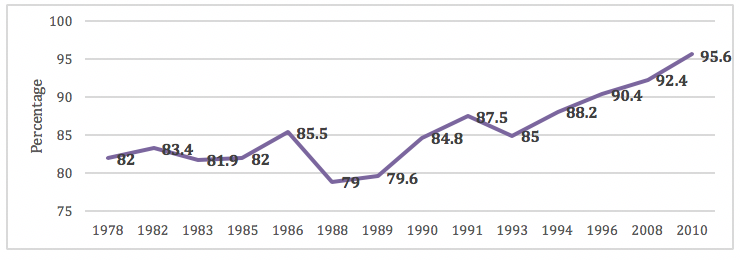
Source: Data from General Social Surveys, 1978–2010.
Figure 3.3 Percentage of People Who Believe Men Make Better Political Leaders than Women
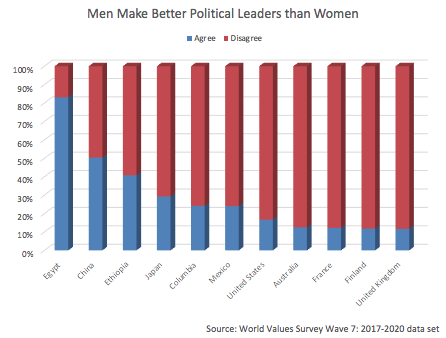
Values
Values are another important element of culture and involve judgments of what is good or bad and desirable or undesirable. A culture’s values shape its norms. In Japan, for example, a central value is group harmony. The Japanese place great emphasis on harmonious social relationships and dislike interpersonal conflict. Individuals are fairly unassertive by American standards, lest they be perceived as trying to force their will on others (Schneider & Silverman, 2010). When interpersonal disputes do arise, Japanese do their best to minimize conflict by trying to resolve the disputes amicably. Lawsuits are thus uncommon; in one case involving disease and death from a mercury-polluted river, some Japanese who dared to sue the company responsible for the mercury poisoning were considered bad citizens (Upham, 1976).
Individualism in the United States

In the United States, of course, the situation is quite different. The American culture extols the rights of the individual and promotes competition in the business and sports worlds and in other areas of life. Lawsuits over the most frivolous of issues are quite common and even expected. Phrases like “Look out for number one!” abound. If the Japanese value harmony and group feeling, Americans value competition and individualism. Because the Japanese value harmony, their norms frown on self-assertion in interpersonal relationships and on lawsuits to correct perceived wrongs. Because Americans value and even thrive on competition, our norms promote assertion in relationships and certainly promote the use of the law to address all kinds of problems.
Figure 3.4 “How Beneficial or Harmful is Competition for Society?” illustrates this difference between various nations’ cultures with data from the 2017-2020 World Values Survey (WVS), which was administered to random samples of the adult populations of more than 80 nations around the world. Figure 3.4 “How Beneficial or Harmful is Competition for Society?” shows the percentages of people from the U.S., Egypt and Zimbabwe who responded that competition is “very beneficial” to society is significantly higher than people in Japan and Finland. Americans are more than twice as likely as Japanese to find competition beneficial.
Figure 3.4 How Beneficial or Harmful is Competition for Society?
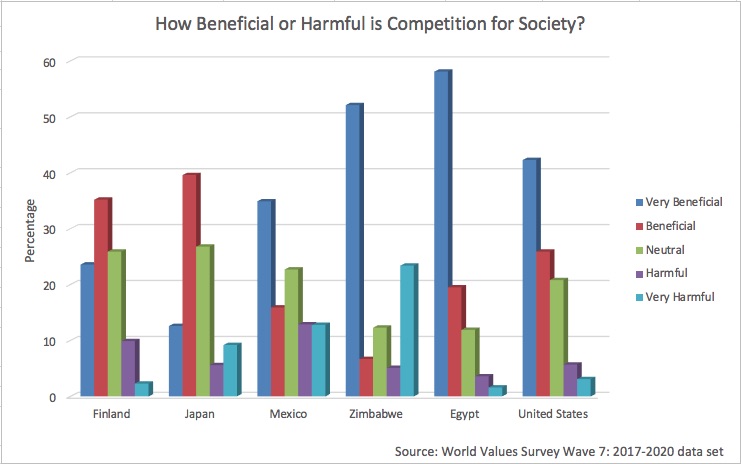
The Japanese value system is a bit of an anomaly, because Japan is an industrial nation with very traditional influences. Its emphasis on group harmony and community is more usually thought of as a value found in traditional societies, while the U.S. emphasis on individuality is more usually thought of as a value found in industrial cultures. Anthropologist David Maybury-Lewis (1998, p. 8) describes this difference as follows: “The heart of the difference between the modern world and the traditional one is that in traditional societies people are a valuable resource and the interrelations between them are carefully tended; in modern society things are the valuables and people are all too often treated as disposable.” In industrial societies, continues Maybury-Lewis, individualism and the rights of the individual are celebrated and any one person’s obligations to the larger community are weakened. Individual achievement becomes more important than values such as kindness, compassion, and generosity.
Other scholars take a less bleak view of industrial society, where they say the spirit of community still lives even as individualism is extolled (Bellah, Madsen, Sullivan, Swidler, & Tipton, 1985). In American society, these two simultaneous values sometimes create tension. In Appalachia, for example, people view themselves as rugged individuals who want to control their own fate. At the same time, they have strong ties to families, relatives, and their neighbors. Thus their sense of independence conflicts with their need for dependence on others (Erikson, 1976).
The Work Ethic
Another important value in the American culture is the work ethic. By the 19th century, Americans had come to view hard work not just as something that had to be done but as something that was morally good to do (Gini, 2000). The commitment to the work ethic remains strong today: in the 2016 General Social Survey, 71% of respondents said they would continue to work even if they got enough money to live as comfortably for the rest of their lives.
Cross-cultural evidence supports the importance of the work ethic in the United States. Using earlier data from the World Values Survey, Figure 3.5 “Percentage Who Prioritize Each Category as Very Important to Society” presents the percentage of people in United States and five other nations from different parts of the world—Finland, Mexico, Egypt, Japan and Zimbabwe—that prioritize work, religion, politics, leisure, family and friends as very important to society.
Figure 3.5 Percentage Who Prioritize Each Category as Very Important to Society

Closely related to the work ethic is the belief that if people work hard enough, they will be successful. Here again the U.S. culture is especially thought to promote the idea that people can pull themselves up by their “bootstraps” if they work hard enough. The WVS asked whether success results from hard work or from luck and connections. Figure 3.6 “Percentage of People Who Think Hard Work Brings Success” presents the proportions of people in the four nations just examined who most strongly thought that hard work brings success. The data shows the percentages of people in each country who responded with a “one” or “two” on a scale of 10 (“one” representing that they completely agreed that “In the long run, hard work usually brings a better life”). Once again, we see evidence of an important aspect of the American culture, as 37% of U.S. residents were likely to think that hard work brings success. Given that the rate of Mexicans agreeing that hard work brings success is over 19% higher than respondents in the U.S., it is clear that the U.S. is not the only country where this belief prevails.
Figure 3.6 Percentage of People Who Think Hard Work Brings Success
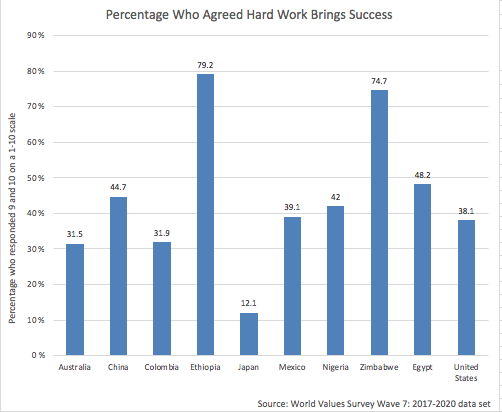
If Americans and Mexicans believe hard work brings success, then they should be more likely than people in other nations to believe that hard work is a desirable quality in their children and they may be less apt to support taxation which redistributes money and other resources to the poor (assuming that the belief that people who are poor do not work hard enough is held consistently within a society). The World Values Survey demonstrates the correlation between the value of hard work and these factors, as demonstrated in the Figure 3.7: “Percentage of People Who See Hard Work as an Important Quality for Children” and Figure 3.8: “Government Taxation of the Rich to Subsidize the Poor is not an Important Characteristic of Democracy.” Figure 3.7 below shows the percentages of survey respondents who chose hard work as a desirable quality in children.
Figure 3.7 Percentage of People Who See Hard Work as an Important Quality for Children
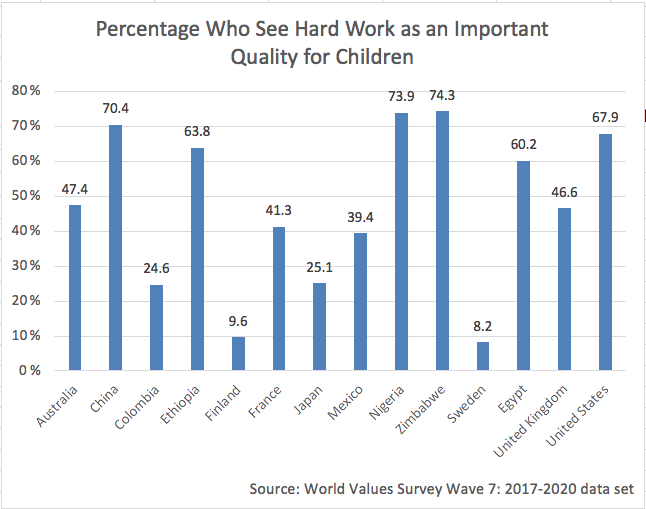
Almost 70% of respondents in the U.S. felt that hard work is an important quality for children, while about 25% of Colombians chose this quality as important, in comparison to much lower percentages in Sweden and Finland. Similarly, Figure 3.8, “Taxation of the Rich to Subsidize the Poor is not an Important Characteristic of Democracy,” demonstrates how the value of hard work correlates with attitudes regarding income redistribution to support the poor in democratic nations. As would be expected, Mexicans and American were the most likely to agree that governmental support of low income individuals is not an important trait of democracy.
Figure 3.8 Taxation of the Rich to Subsidize the Poor is not an Important Characteristic of Democracy
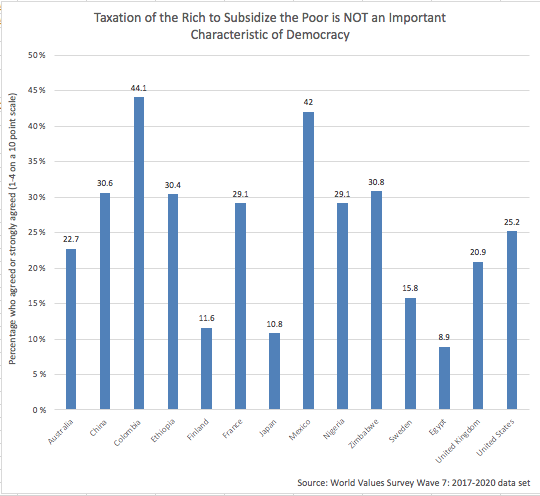
We could discuss many other values, but an important one concerns how much a society values women’s employment outside the home. The WVS asked respondents whether they agree that “when jobs are scarce men should have more right to a job than women.” Figure 3.9 “Percentage Who Agree That Men Have More Right to a Job Than Women When Employment is Scarce” shows that U.S. residents are more likely than those in nations with more traditional views of women, such as Japan and Jordan, to disagree with this statement.
Figure 3.9 Percentage Who Agree That Men Have More Right to a Job Than Women When Employment is Scarce
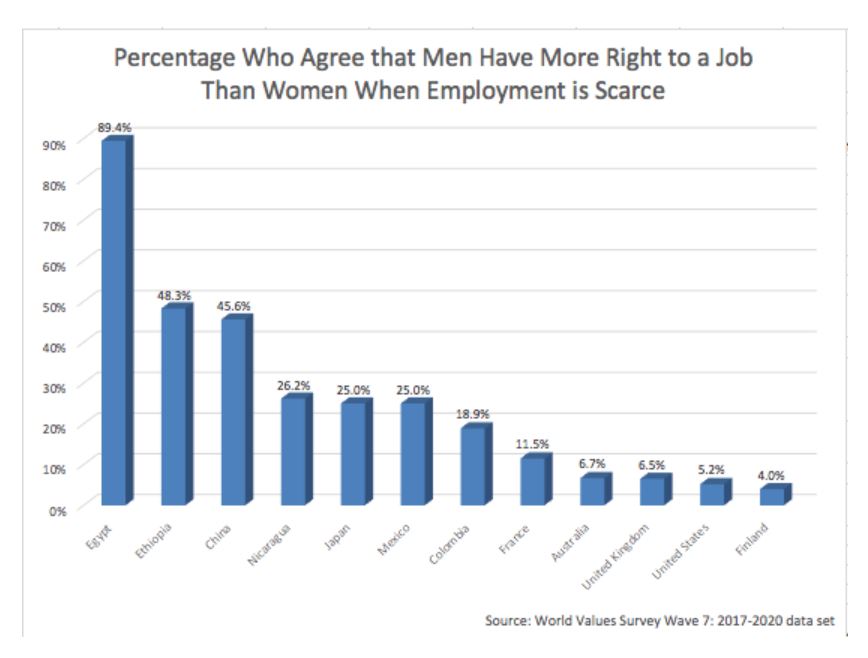
Artifacts
The last element of culture is the artifacts, or material objects, that constitute a society’s material culture. In most preindustrial societies, artifacts are largely limited to a few tools, the huts people live in, and the clothing they wear. One of the most important inventions in the evolution of society was the wheel. Figure 3.10 “Primary Means of Moving Heavy Loads” shows that very few of the societies in the SCCS use wheels to move heavy loads over land, while the majority use human power and about one-third use pack animals.
Figure 3.10 Primary Means of Moving Heavy Loads
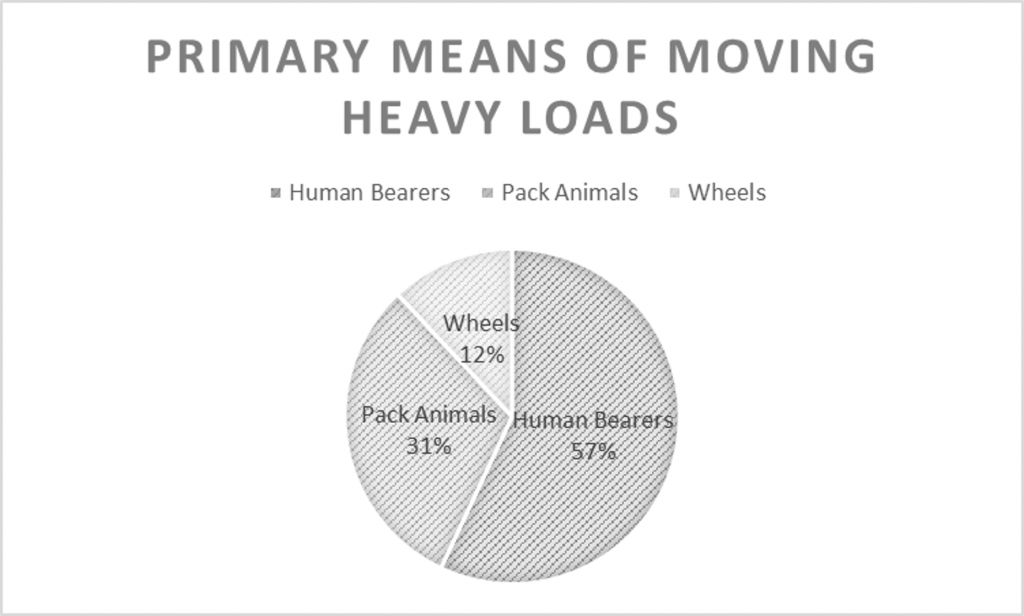
Although the wheel was a great invention, artifacts are much more numerous and complex in industrial societies. Because of technological advances during the past two decades, many such societies today may be said to have a wireless culture, as smartphones, netbooks and laptops, and GPS devices now dominate so much of modern life. The artifacts associated with this culture were unknown a generation ago. Technological development created these artifacts and new language to describe them and the functions they perform. Today’s wireless artifacts in turn help reinforce our own commitment to wireless technology as a way of life, if only because children are now growing up with them, often even before they can read and write.
Sometimes people in one society may find it difficult to understand the artifacts that are an important part of another society’s culture. If a member of a tribal society who had never seen a cell phone, or who had never even used batteries or electricity, were somehow to visit the United States, she or he would obviously have no idea of what a cell phone was or of its importance in almost everything we do these days. Conversely, if we were to visit that person’s society, we might not appreciate the importance of some of its artifacts.
In this regard, consider once again India’s cows, discussed in the news article that began this chapter. As the article mentioned, people from India consider cows holy, and they let cows roam the streets of many cities. In a nation where hunger is so rampant, such cow worship is difficult to understand, at least to Americans, because a ready source of meat is being ignored.
Anthropologist Marvin Harris (1974) advanced a practical explanation for India’s cow worship. Millions of Indians are peasants who rely on their farms for their food and thus their existence. Oxen and water buffalo, not tractors, are the way they plow their fields. If their ox falls sick or dies, farmers may lose their farms. Because, as Harris observes, oxen are made by cows, it thus becomes essential to preserve cows at all costs. In India, cows also act as an essential source of fertilizer, to the tune of 700 million tons of manure annually, about half of which is used for fertilizer and the other half of which is used as fuel for cooking. Cow manure is also mixed with water and used as flooring material over dirt floors in Indian households. For all of these reasons, cow worship is not so puzzling after all, because it helps preserve animals that are very important for India’s economy and other aspects of its way of life.

If Indians exalt cows, many Jews and Muslims feel the opposite about pigs: they refuse to eat any product made from pigs and so obey an injunction from the Old Testament of the Bible and from the Quran. Harris thinks this injunction existed because pig farming in ancient times would have threatened the ecology of the Middle East. Sheep and cattle eat primarily grass, while pigs eat foods that people eat, such as nuts, fruits, and especially grains. In another problem, pigs do not provide milk and are much more difficult to herd than sheep or cattle. Next, pigs do not thrive well in the hot, dry climate in which the people of the Old Testament and Quran lived. Finally, sheep and cattle were a source of food back then because beyond their own meat they provided milk, cheese, and manure, and cattle were also used for plowing. In contrast, pigs would have provided only their own meat. Because sheep and cattle were more “versatile” in all of these ways, and because of the other problems pigs would have posed, it made sense for the eating of pork to be prohibited.
In contrast to Jews and Muslims, at least one society, the Maring of the mountains of New Guinea, is characterized by “pig love.” Here pigs are held in the highest regard. The Maring sleep next to pigs, give them names and talk to them, feed them table scraps, and once or twice every generation have a mass pig sacrifice that is intended to ensure the future health and welfare of Maring society. Harris explains their love of pigs by noting that their climate is ideally suited to raising pigs, which are an important source of meat for the Maring. Because too many pigs would overrun the Maring, their periodic pig sacrifices help keep the pig population to manageable levels. Pig love thus makes as much sense for the Maring as pig hatred did for people in the time of the Old Testament and the Quran.
3.3 Cultural Diversity
These cow and pig examples remind us that material and nonmaterial cultures often make sense only in the context of a given society. If that is true, then it is important for outsiders to become familiar with other societies and to appreciate their cultural differences. These differences are often referred to as cultural diversity. Cultural diversity also occurs within a single society, where subcultures and counter cultures can both exist.
|
Learning from Other Societies Saving Dogs and Cats in South Korea Sometimes citizens can make a difference. Dog ownership has recently been increasing in South Korea, a nation in which dogs have traditionally been preferred more as a source of food than as pets. Two individuals who can claim credit for the more humane treatment of dogs there are Kyenan Kum and Haesun Park, two women who founded the Korea Animal Protection and Education Society (KAPES; http://www.koreananimals.org/ index.htm) in 2007. The mission of KAPES is to educate South Koreans about the humane treatment of dogs and cats and to promote compassionate treatment of these pets. Kyenan Kum had previously founded the International Aid for Korean Animals (IAKA) organization in 1997, to achieve the same goals. During the next 10 years, IAKA advocated for the more humane treatment of pets and publicized their plight to other nations to help bring international pressure to bear on South Korea. In 2007, IAKA’s efforts proved successful when the Korean government strengthened its Animal Protection Law. With stronger legal protections for pets in place, Kum and Park decided it was now time to focus on convincing the public that pets should be treated humanely, and they founded KAPES to achieve this goal. In December 2008, Park received an award from the Ministry of Agriculture for her efforts, which have included the holding of animal protection festivals and advocating for government funding for animal shelters. It is not easy to confront a deeply embedded cultural practice as Kyenan Kum and Haesun Park have done. Their example offers inspiration to Americans and other citizens who also dedicate their lives to various kinds of social reforms. However, one thing to remember here is that the influence of globalization and the spread of Western ideology aided their efforts immensely. |
A subculture refers to a group that shares the central values and beliefs of the larger culture but still retains certain values, beliefs, and norms that make it distinct from the larger culture. Subcultures may have a special shared interest, language (also known as argot), way of dress, special holidays, etc. We may belong to multiple subcultures. Nurses, professors, bartenders, scrap-bookers, police officers, and college students are all good examples of subcultures. As a college student you have a special way of life that involves studying, attending class, reading, etc. and you have a special language which and includes things like “syllabus.” Nurses or police officers have a special language they use, a shared way of life, and a shared way of dress that distinguishes them from the mainstream when they are interacting within their subculture.
Figure 3.11
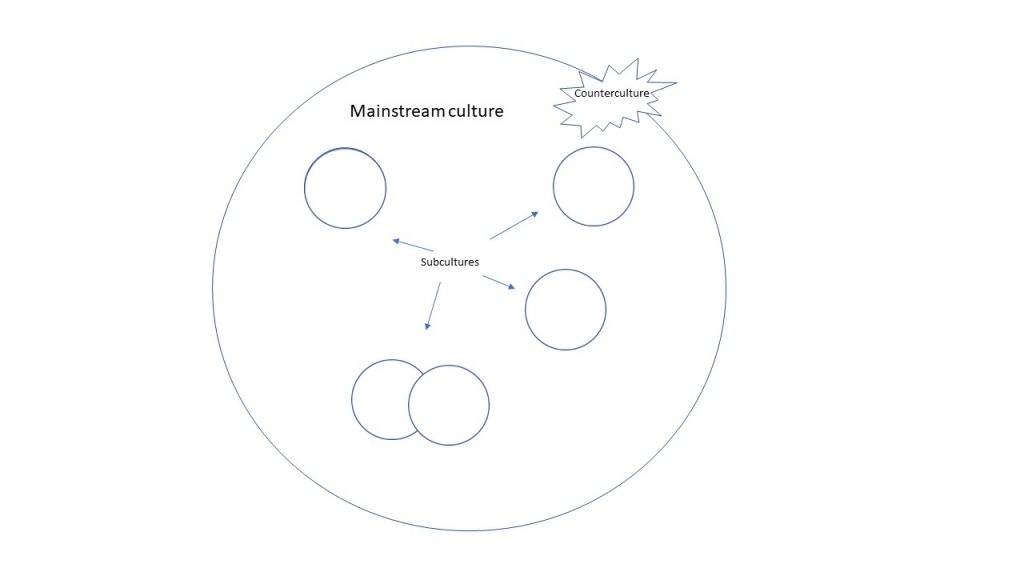
A counterculture is a group whose values and beliefs directly oppose those of the larger culture and even reject it. Perhaps the most discussed example of a counterculture is the so-called youth counterculture of the 1960s, often referred to as the hippies but also comprising many other young people who did not fit the “tuned out” image of the hippies and instead were politically engaged against U.S. government policy in Vietnam and elsewhere (Roszak, 1969). Another good example of a U.S. counterculture is the Amish, who live primarily in central Pennsylvania and parts of Ohio and shun electricity and other modern conveniences, including cars, tractors, and telephones. Their way of life is increasingly threatened by the expansion of non-Amish businesses and residences into Amish territory (Rifkin, 2009). Since the 1970s, development has cost Lancaster County, Pennsylvania—where many Amish live—thousands of acres of farming land. Some Amish families have moved to other states or left farming to start small businesses, where some do use cell phones and computers. Despite these concessions to modern development, for the most part the Amish live the way they always have. Most still do not drive cars or even ride bikes. The case of the Amish illustrate the persistence of counterculture and its uneasy fit with the larger, dominant culture.A contemporary example of a U.S. counterculture is the survivalists, whose extreme antigovernment views and hoarding of weapons fit them into the counterculture category (Mitchell, 2002).

Cultural Relativism and Ethnocentrism
The fact of cultural diversity raises some important but difficult questions of cultural relativism and ethnocentrism. Cultural relativism refers to the belief that we should not judge any culture as superior or inferior to another culture. In this view, all cultures have their benefits and disadvantages, and we should not automatically assume that our own culture is better and “their” culture is worse. Ethnocentrism, the opposite view, refers to the tendency to judge another culture by the standards of our own and to the belief that our own culture is indeed superior to another culture. If we are exposed to a culture we are not familiar with, it is very possible that we will experience culture shock. Culture shock is the uncomfortable or bewildered feeling we might have when immersed in a new culture. It is easy to see how quickly one could be ethnocentric about a culture that they are already unfamiliar with. When we think of cow worship in India, it is easy to be amused by it and even to make fun of it. That is why anthropologist Marvin Harris’s analysis was so important, because it suggests that cow worship is in fact very important for the Indian way of life.
Some scholars think cultural relativism is an absolute, that we should never judge another culture’s beliefs and practices as inferior to our own. Other scholars think cultural relativism makes sense up to a point, but that there are some practices that should be condemned, even if they are an important part of another culture, because they violate the most basic standards of humanity. For example, a common practice in areas of India and Pakistan is dowry deaths, where a husband and his relatives murder the husband’s wife because her family has not provided the dowry they promised when the couple got married (Kethineni & Srinivasan, 2009). Often, they burn the wife in her kitchen with cooking oil or gasoline and make it look like an accident. The number of such dowry deaths is estimated to be at least several hundred every year and perhaps as many as several thousand. Should we practice cultural relativism and not disapprove of dowry deaths? Or is it fair to condemn this practice, even if it is one that many people in those nations accept?

Because dowry death is so horrible, you might be sure we should not practice cultural relativism for this example. However, other cultural practices such as cow worship might sound odd to you but are not harmful, and you would probably agree we should accept these practices on their own terms. Other practices lie between these two extremes. Consider the eating of dog meat, which was mentioned in the “Learning From Other Societies” box. In China, South Korea, and other parts of Asia, dog meat is considered a delicacy, and people sometimes kill dogs to eat them (Dunlop, 2008). As one observer provocatively asked about eating dog meat, “For a Westerner, eating it can feel a little strange, but is it morally different from eating, say, pork? The dogs brought to table in China are not people’s pets, but are raised as food, like pigs. And pigs, of course, are also intelligent and friendly” (Dunlop, 2008). Should we accept the practice of eating dog meat on its own terms? Is it any worse than eating pork or slaughtering cattle in order to eat beef? If an Asian immigrant killed and ate a dog in the United States, should that person be arrested for engaging in a practice the person grew up with? Cultural relativism and ethnocentrism certainly raise difficult issues in today’s increasingly globalized world.
3.4 End-of-Chapter Material
- Culture involves the symbols, language, norms, values, and artifacts that characterize any society and that shape the thoughts, behaviors, and attitudes of the members of the society.
- Scholars continue to debate the relative importance of biology and culture for human behavior. Sociologists favor culture over biology for several reasons, including the cultural variations existing around the world, the inability of biological explanations to account for many differences in groups’ rates of behavior, and the support of biological explanations of behavior for the status quo.
- Symbols are an important part of culture and help members of a society interact. They include both objects and nonverbal means of communication. Failure to understand the meanings of symbols can make it difficult to interact.
- Language is another important element of culture and fundamental to communication. If the Sapir-Whorf hypothesis is correct, language shapes the thoughts and perceptions of society’s members.
- A culture’s norms and values influence how people behave. When we look around the world, we see several dramatic illustrations of cross-cultural variation in norms and values. In Japan, for example, harmony is a central value, while in the United States individualism and competition prevail.
- Artifacts are the final element of culture and may prove puzzling to people outside a given culture. However, artifacts often make much sense from the perspective of the people living amid a given culture.
- Cultural relativism and ethnocentrism are two sides of the same coin in the issue of cultural diversity. Many societies have cultural practices that may surprise and even dismay us, and it’s often difficult to decide whether we should accept or instead condemn these practices.
